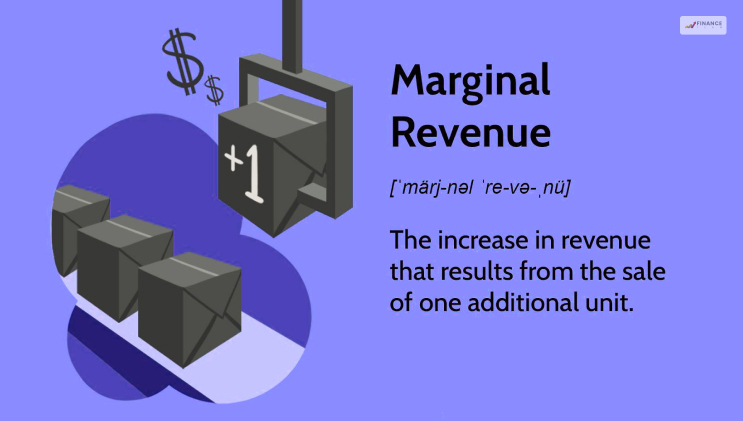How To Find Marginal Revenue? – Discover With Example

How To Find Marginal Revenue?
Marginal revenue, like all the other aspects of a business’s revenue, is crucial. It offers valuable insights that can be used later for investment and business. Calculating marginal revenue comes with different financial and managerial applications.
A business can use this part of the revenue to understand the demands of the customers, plan the schedules for production, and set price for their products.
So, what is the formula for calculating marginal revenue? Let’s find out in this article.
What is Marginal Revenue?

Similar to different other economic concepts that detect the profitability of any business, Marginal revenue, too, is an important metric. It suggests the revenue generated by selling additional product units that potentially affect the increment in earnings.
This revenue is subject to the law of diminishing returns. As a result, once output levels increase, it will slow down. This process applies to both small and large-sized businesses. They can examine this revenue and check out the profitability improved through sales of additional product units.
That is why companies trying to maximize their profitability must increase their production rate until the marginal revenue and costs are on the same level. On the flip side of the coin, businesses can stop their production when the marginal revenue lowers compared to the marginal cost.
According to economic theories, the best practice is that – companies will have to keep producing until marginal revenue is the same as marginal cost.
Key Points
- Marginal revenue suggests the increment of the revenue generated due to the increased sales of additional product units.
- A business must first analyze its total revenue before calculating its total revenue.
- A business can modify its product’s pricing and set competitive prices for better profitability and more sales numbers.
- The marginal revenue is a product-specific revenue metric. Businesses producing multiple products with different pricing will have to calculate marginal revenue separately for each product.
Formula For Marginal Revenue With Example

So the goal of a business is to keep producing until the marginal revenue and the marginal cost are the same.
Let’s say that a company sells shoes for $10. The shoes sold on Monday are 100 in number. So, the total cost of the total units sold is $1000. But, if the company sells 110 shoes on the next day at the same price, then the total cost of the units sold will be $1100.
The difference in the amount generated from selling ten more shoes on Monday helps the company generate its marginal revenue. In this case, the marginal revenue will be – $100.
So, how to find marginal revenue? All you have to do is to follow the formula given below –
| Marginal revenue = change in the revenue/change in the quantity |
Now, you can take it one step further. Here is a more detailed formula for the same –
| Marginal revenue = (current revenue – initial revenue) / (current product quantity – initial product quantity) |
How To Find Marginal Revenue?

Here is the guideline on how to calculate marginal revenue –
First, Find Your Total Revenue
The first step towards finding marginal revenue is finding the company’s total revenue. You can find it by multiplying the product units sold by the price of each of the products.
Here is the formula for total revenue –
Current Sales X Current Product Price Per Unit = Total Revenue
For example, if the total number of products sold in a company is 100 and the price for each of the units is $5, the total revenue would be – 100 x $5 = $500.
Secondly, Exercise Market Research

Now, in calculating the marginal revenue, you must run quick market research. Why? Because this will offer you a clear overview of other product alternatives sold at lower prices and sold at a higher number.
You must analyze your competitors who are selling the same product. Check out their price and the total amount they sell within the timeframe. Companies can usually sell more if the price of the products is lower; the demand increases in that case.
Thirdly, Find Alternate Revenue

Finding the alt revenue gives businesses insight into how much they could have generated in revenue if the price were low. This can be done using the alternate number of products that could be sold and the alternative lower product price. The formula is quite similar to finding total revenue.
[alternate sales] x [alternate price] = alt revenue
For example, if the price of each of your product units were $3 instead, and if you could sell 300 units, then the revenue would be –
300 x $3 = $900.
Fourth, Use The Marginal Cost Equation
So, now we are at the final step for calculating the marginal revenue for the company. You have to apply the alt and total revenue data and put the info in the marginal revenue formula. You have to subtract the total revenue from the alternate revenue first. Then divide the result by subtracting current sales from the alternate revenue.
Here is the formula –
[Alternate revenue – current revenue ] / [alternate sales – current sales]
Here, we will take the previous data example we have created in the previous sections. According to our previous calculations, here are some data we will use –
- Total revenue – $500
- Alt revenue – $900
- Alternate sales price – $3
- Current sales price – $5
- Total sales number – 100
- Alternate sales number – 300
In this case, the calculator would be as follows –
($900 -$500)/(300 -100)= $400 / 200 = $2
Finally, Analyze The Financial Records

Once a business has its marginal revenue calculated, it can use the data to analyze different other financial records of the business. However, one must remember that marginal revenue is a product-specific revenue metric.
Bottom Line
Identifying marginal revenue is a key contributor to how a product is priced. That is why it is common for new business startups to ask this question – how to find marginal revenue? However, you should already have the answer if you have gone through this article.
On the other hand, if you need any further clarification, reach out to us through the comment section.
Read Also:










